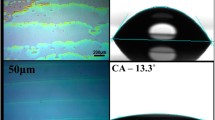Abstract
Inkjet printing of TiO2 potentially offers a high degree of control over the deposition of TiO2 suspensions. Previous use of inkjet printing for TiO2 depositions have focused on producing TiO2 films with uniform density. A multi-ink printing system offers the possibility of depositing TiO2 films with variable density using a single deposition method.
For this research, inkjet printing of TiO2 films with a graded density profile was explored as a means of improving dye sensitized solar cells (DSSCs) performance. Varying pore volume as a means to produce density variations in TiO2 layers was explored. To control the pore volume, several TiO2 suspensions were developed with different pore-forming additives. DSSCs with printed TiO2 films having three density layers showed an average improvement in the conversion efficiency of 127% versus those with a single layer and 45% versus those with dual-layer TiO2. Short-circuit current densities of cells with tri-layer films increased an average of 62% over those with a single layer and 17% over those with dual-layer TiO2. It was also shown that DSSCs with inkjet printed TiO2 layers performed better than those with spin-coated TiO2 layers.
The results effectively demonstrated the potential for using inkjet printing as a sole deposition method to produce TiO2 films with non-uniform density leading to improved DSSC performance. One possibility for further study is to create further layer variations through simultaneous printing of different suspensions.
Similar content being viewed by others
References
Hagfeldt A., Boschloo G., Sun L., Kloo L., & Pettersson H. (2010). Dye-sensitized solar cells. Chemical Review, 110, 6595–6663.
Zhang Q., & Cao G. (2011). Nanostructured photoelectrodes for dye-sensitized solar cells. Nano Today, 2011(9), 91–109.
Mohammadi M. R., Louca R. R., Fray D. J., & Welland M. E. (2012). Dye-sensitized solar cells based on a single layer deposition of TiO2 from a new formulation paste and their photovoltaic performance. Solar Energy, 86, 2654–2664.
Wang Z, Kawauchi H, Kashima T, Arakawa H, (2004). Significant influence of TiO2 photoelectrode morphology on the energy conversion efficiency of N719 dye-sensitized solar cell. Coordination Chemistry Reviews, 248, Issues 13–14, 1381–1389.
Kuscer D., Stavber G., Trefalt G., & Kosec M. (2012). Formulation of an aqueous titania suspension and its patterning with ink-jet printing technology. Journal of The American Ceramic Society, 95(2), 487–493.
Cerna M., Vesely M., & Dzik P. (2011). Physical and chemical properties of titanium dioxide printed layers. Catalysis Today, 161, 97–104.
Morozova M., Kluson P., Krysa J., Vesely M., Dzik P., & Solcova O. (2012). Electrochemical properties of TiO2 electrode prepared by various methods. Procedia Engineering, 42, 573–580.
Yang M., Li L., Zhang S., Li G., & Zhao H. (2010). Preparation, characterization and sensing application of inkjet-printed nanostructured TiO2 photoanode. Sensors and Actuators B: Chemical, 147, 622–628.
Dang M. C., Dang T. M., & Fribourg-Blanc E. (2013). Inkjet printing technology and conductive inks synthesis for microfabrication techniques. Advances in Natural Sciences: Nanoscience and Nanotechnology, 4(1), 1–7.
Su C., Hung W., Lin C., & Chien S. (2010). The preparation of composite TiO2 electrodes for dye-sensitized solar cells. Journal of the Chinese Chemical Society, 57, 1131–1135.
Lejeune M., Chartier T., Dossou-Yovo C., & Noguera R. (2009). Inkjet printing of ceramic micro-pillar arrays. Journal of the European Ceramic Society, 29, 905–911.
Arin M., Lommens P., Avci N., Hopkins S. C., De Buysser K., Arabatzis I. M., Fasaki I., Poelman D., & Van Driessche I. (2011). Inkjet printing of photocatalytically active TiO2 thin films from water based precursor solutions. Journal of the European Ceramic Society, 31, 1067–1074.
Oh Y., Yoon H. G., Lee S., Kim H., & Kim J. (2012). Inkjet-printing of TiO2 co-solvent ink: From uniform ink-droplet to TiO2 photoelectrode for dye-sensitized solar cells. Journal of the Electrochemical Society, 159(1), 35–39.
Author information
Authors and Affiliations
Rights and permissions
About this article
Cite this article
Johnson, J., Jiao, L.(. Inkjet Printing of Titanium Dioxide Photoanodes for Dye Sensitized Solar Cells. MRS Online Proceedings Library 1667, 52–57 (2014). https://doi.org/10.1557/opl.2014.901
Published:
Issue Date:
DOI: https://doi.org/10.1557/opl.2014.901




